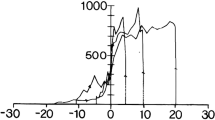Abstract
This paper presents a model of saccadic eye movements. Eye movements are considered as being ballistic, since saccades (rapid concurrent movements of both eyes) occur several hundred thousand times per day; visual perception of the environment is interrupted by a saccade. The optimal control was constructed for the motion considered in three consecutively refined assumptions. The controls included in the time-optimal problem were the resultant moment of force exerted by the extraocular muscles, individual moments of force exerted by either muscle of the agonist–antagonist pair, and finally, the rate of change of these moments. This approach is consistent with the view that is currently upheld by physiologists, who believe that a saccade is programmed by the central nervous system before the beginning of an eye movement and is scarcely adjusted during the movement itself. The solution of the optimal control problem and the results obtained by subsequent numerical modeling of saccadic trajectories were compared with the published experimental data. The saccadic trajectories were compared based on the main sequence, the known consistent relationship between saccade amplitude and duration, which is the most widely applied and commonly accepted way of describing saccade data. The main sequence of saccades obtained from the solution of the optimal control problem formulated in the most complete form agreed well with published experimental results.
Similar content being viewed by others
References
D. C. Burr and J. Ross, Vision Res. 28, 479 (1982).
A. L. Yarbus, The Role of Eye Movements in the Process of Vision (Nauka, Moscow, 1965) [in Russian].
V. A. Filin, Saccadic Automatism (Moscow State Univ., Moscow, 2002) [in Russian].
M. R. Clark and L. Stark, IEEE Trans. Automat. Control 20, 345 (1975).
E. Burdette, R. Osu, D. W. Franklin, et al., Nature 414, 446 (2001).
T. Yu. Bokov, A. F. Suchalkina, E. V. Yakusheva, et al., Ross. Zh. Biomekh. 18 (1), 48 (2014).
A. G. Yakushev, D. A. Napalkov, P. O. Ratmanova, et al., Ross. Zh. Biomekh. 15 (1), 99 (2011).
H. Nakahara, K. Nakamura, and O. Hikosaka, Neural Netw. 19 (8), 1027 (2006).
H. Tanaka, J. W. Krakauer, and N. Qian, Neurophysiology 95, 3875 (2006).
Human Physiology, Ed. by R. F. Schmidt and G. Thews (Springer, Berlin, 1989; Mir, Moscow, 2005), Vol.3.
A. T. Bahil and B. T. Troost, Neurology 29 (8), 1150 (1979).
L. N. Kornilova, I. A. Naumov, D. O. Glukhikh, et al., Hum. Physiol. 39 (5), 462 (2013).
L. N. Kornilova, S. V. Sagalovitch, V. V. Temnikova, et al., J. Vestibular Res. 17 (5–6), 217 (2007).
L. N. Kornilova, V. V. Temnikova, S. V. Sagalovitch, et al., Physiol. J. 93 (2), 128 (2007).
O. Yu. Shtefanova and A. G. Yakushev, Vestn. Mosk. Univ., Ser. 1: Math. Mech., No. 4, 63 (2008).
A. G. Yakushev, V. I. Dotsenko, L. A. Kulakova, et al., Funkts. Diagn., No. 4, 41 (2010).
A. G. Yakushev and A. A. Yakushev, Izv. Yuzhn. Fed. Univ., Tekhn. Nauki, No. 8, 210 (2010).
B. Happee, Biol. Cybernet. 66, 357 (1992).
E. N. Marieb and K. Hoehn, Human Anatomy and Physiology, 8th ed. (Benjamin Cummings, San Francisco, 2010).
A. C. Smit, J. A. M. Van Gisbergen, and A. R. Cools, Vision Res. 27 (10), 1745 (1987).
V. I. Gurman, The Extension Principle in Control Problems, 2nd ed. (Nauka, Moscow, 1997) [in Russian].
A. A. Feldbaum, Fundamentals of the Theory of Optimal Automatic Systems, 2nd ed. (Nauka, Moscow, 1966) [in Russian].
A. Arutyunov, D. Karamzin, and F. R. V. Pereira, Dokl. Math. 83 (1), 131 (2011).
Author information
Authors and Affiliations
Corresponding author
Additional information
Original Russian Text © A.P. Kruchinina, A.G. Yakushev, 2018, published in Biofizika, 2018, Vol. 63, No. 2, pp. 334–341.
Rights and permissions
About this article
Cite this article
Kruchinina, A.P., Yakushev, A.G. A Mathematical Model of Optimal Saccadic Eye Movement by a Pair of Muscles. BIOPHYSICS 63, 241–247 (2018). https://doi.org/10.1134/S0006350918020161
Received:
Published:
Issue Date:
DOI: https://doi.org/10.1134/S0006350918020161




